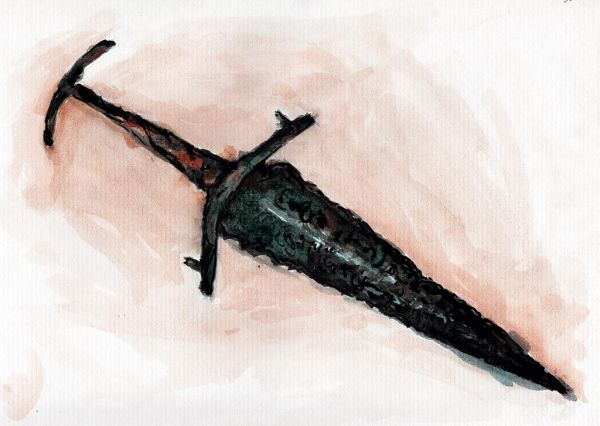Difference between revisions of "Dirak"
ScruffyHugo (talk | contribs) |
ScruffyHugo (talk | contribs) |
||
| Line 1: | Line 1: | ||
| − | [[File:Lume_Relic_Dirak_web.jpg|thumb| | + | [[File:Lume_Relic_Dirak_web.jpg|thumb|600px|border|right|Sketch of ''Morsu'', the dirak last seen in the possession of a wandering mercenary. It is curious the artist was able to depict the blade, usually hidden from view.]] |
== Relic: Anima Dirak ''(Dira letalis)'' == | == Relic: Anima Dirak ''(Dira letalis)'' == | ||
Latest revision as of 15:39, 15 November 2021
Relic: Anima Dirak (Dira letalis)
The diraks were cunning daggers of malignant purpose. Records indicate several were made during the early rumblings of the Schism; dirks crafted specifically to frustrate Anima wielders. In an unlikely alliance, the Deumana Vesselen Ukin and Atlover Atir collaborated in fashioning these instruments of stealth for their loyal assassins. For not all Folk were want to rise up against their overlords.
The Deumana were loathe to find fatally wounded rebel leaders returning to the foray, healed thanks to the skills of Folk Necromancers. While the demi-gods were not capable of replicating the Folks' innate connection with Anima in their gene tanks, they could hinder it. With the unwilling help of a captive Caster, they pressed the development of blades impregnated with dormant, corrosive fungi. Once flesh was slashed or stabbed, these enhanced spores took root in the area, working to reopen the wound, and corroding it with bacterial growth. Healers attempted to siphon Anima from numerous willing participants in order to heal an afflicted chief, only for the spores to reopen the wound. If the graze was small and the Anima in great supply, the spores could be overcome, but the injury inflicted was typically considered fatal; defiant to nearly all ministrations. And during these healer's impeded attempts, the victim suffered the searing blight of infection.
By necessity, Diraks were made with certain qualities, aside from their primary one. The grip and crossguard were unadorned, so as not to raise suspicion, and the pommel flared to allow a second hand to help drive the blade deep enough to penetrate tough hide and armor. The cross-guard had small knobs to prevent the wielder from slipping onto the blade, though this offered false security, as the assassin was dispensable. The blade itself was unmistakable, as the spores embedded in the fuller created pronounced black sworls along the blade. Records say this was obscured by a plain leather scabbard, and discreetly strong chape and throat fitting, to give the sheath strength. The scabbards and grips have not survived the cycles - the metal corroding and pocking, the blades chipped and toothy; adding to their malaise.
There are two examples extant the library is aware of. One is kept safely on premises, another was last seen in the hands of the mercenary Trass. It is likely there are more stashed around Lume, as during the latter days of the Schism, the Deumana were said to have produced them in greater numbers, in the hopes of arming their improvised infantry. Thankfully, this stash remains undisclosed, the technology has not been replicated, and Casters are driven to destroy any diraks they come across.
The dirak Fester began its existence in a processing laboratory, and quickly found itself possessed by an ambitious Slender Assistant. After having dispatched an inconvenient Arch-Academic, the nerve-wracked wielder returned to its patrons, only to be quickly disposed of. The blade was not long idle, for it was gifted to a Faux Giant general, and acquiring a taste for copious victims, relished this life of unbridled violence. Once the Faux Giant perished, the blade was unceremoniously tossed into caverns, along with all the other tainted relics of the era. Over time the grip dried, cracked, and rotted away, as did the scabbard. But the blade lost none of its potency. Uncovered by a Dunekin Sunfolk, and traded to a Archaesociologist Slender, it once again found itself in the Great library. Fester now sits alongside a bust of the Arch-Academic it slew. And waits.

